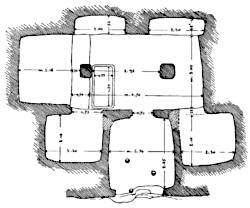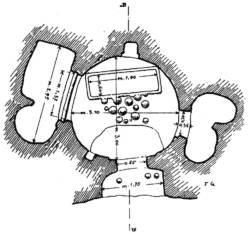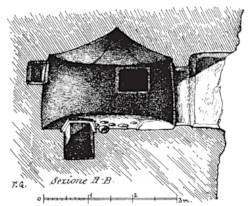Necropoli di Sant’Andrea Priu
Useful Information


| Location: |
Piana Santa Lucia, 07012 Bonorva SS.
From Bonorva SP43 6 km, turn right towards church of Santa Lucia 4 km. (40.4214926, 8.8473733) |
| Open: |
MAR daily 10-13, 15-17:30. APR daily 10-13, 15-18. MAY to JUN daily 10-13, 15-18:30. JUL to SEP daily 10-19. OCT daily 10-13, 15-17:30. [2025] |
| Fee: |
Adults EUR 7, Children (11-16) EUR 5, Children (0-10) free. Groups (20+): Adults EUR 5. [2025] |
| Classification: |
 Cave Tomb Cave Tomb
 Domus de Janas Domus de Janas
|
| Light: |
 Incandescent Incandescent
|
| Dimension: | |
| Guided tours: | self guided |
| Photography: | allowed |
| Accessibility: | no |
| Bibliography: |
Roberto Caprara (1986):
La Necropoli di S. Andrea Priu
Delfino, Sassari 1986, (Sardegna archeologica. Guide e itinerari 3).
|
| Address: | Necropoli di Sant’Andrea Priu, Piana Santa Lucia, 07012 Bonorva SS, Tel: +39-348-564-2611. |
| As far as we know this information was accurate when it was published (see years in brackets), but may have changed since then. Please check rates and details directly with the companies in question if you need more recent info. |
|
History
| 1986 | Cooperativa Costaval founded for the development and protection of the local history. |
| 1997 | Costaval Cooperative operates the Necropoli di Sant’Andrea Priu. |
| 1999 | Costaval Cooperative operates the Archaeological Museum of Bonorva. |
Description


Necropoli di Sant’Andrea Priu is one of the best developed sites of the pre-Nuraghe tombs. They have electric light and there are registered guides, it is operated by Cooperativa Costaval (Costaval Cooperative), which is actually the company of the three guides. So if you want to see typical and well preserved Domus de Janas, this is the first choice. The site has 20 tombs, the main tomb is called Tomba del Capo (Tomb of the Chief) and has 18 rooms. The visitors were obviously impressed by the size and the number of rooms, and so they thought it was the tomb of somebody important. With an area of 180 m² it is the largest cave tomb on Sardinia.
The site is a spectacular outcrop of trachyte, which forms a 180 m long and 10 m high cliff. This trachyte is a common volcanic rock, typically it is porous, and it is often quarried for the construction of buildings. Obviously it was also suitable for digging cave tombs. The entrances are all in the rock face, most are easy to reach, some are higher up. However, due to the enormous age and partly because of later alterations, several tombs are damaged in the entrance area. For several tombs a part of the entrance section is missing. There were once 20 tombs, 5 were destroyed, so 15 tombs remain. Some are quite small, unimpressive or fragile, so actually the visitor sees only four tombs.
- Tomb 5 is named Tomba a capanna circolare (Circular hut tomb), has a short dromos and a single main chamber which is circular, hence the name. Notable are small bowls in the floor, a 1.9 m long coffin-like depression, the upper edge of which is cut out to accommodate a grave slab, and the asymmetrically curved side chambers of different sizes.
- Tomb 6 is the already mentioned Tomba del Capo (Tomb of the Chief). It starts with a partly destroyed and thus rather short dromos, followed by a semicircular vestibule. It is adjoined by two large main rooms supported by pairs of round columns and arranged one behind the other. The main rooms have six side chambers, which are partly accessible via steps, and which have smaller side chambers. It’s not symmetric, one of the chambers has three secondary chambers, the other five each have one secondary chamber. There are frescoes from the 3rd-9th century, younger frescoes are from the 17th century, and a light well was knocked into the ceiling of the rear main room at the same time.
- Tomb 8 is named Tomba a Camera (Chamber Tomb), because it has only one main room supported by two square columns with two coffin sized niches which are quite unusual. Most likely they were added much later when the tomb was reused as a tomb.
- Tomb 10 has no name, it has a wide anteroom but no main room supported by columns. A load-bearing wall protrudes into the room. In the floor of one of the seven side chambers, some of which are quite small, there is again a coffin-like recess.
 Search DuckDuckGo for "Necropoli di Sant’Andrea Priu"
Search DuckDuckGo for "Necropoli di Sant’Andrea Priu" Google Earth Placemark
Google Earth Placemark OpenStreetMap
OpenStreetMap Necropolis of Sant’Andrea Priu - Wikipedia (visited: 21-AUG-2025)
Necropolis of Sant’Andrea Priu - Wikipedia (visited: 21-AUG-2025) Cooperativa Costaval, official website
Cooperativa Costaval, official website  (visited: 20-AUG-2025)
(visited: 20-AUG-2025) Index
Index Hierarchical
Hierarchical Countries
Countries Maps
Maps